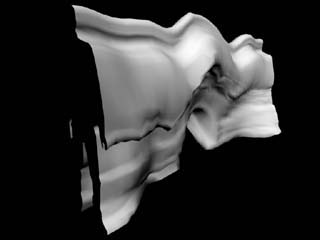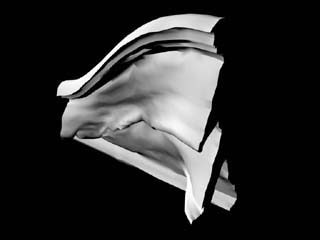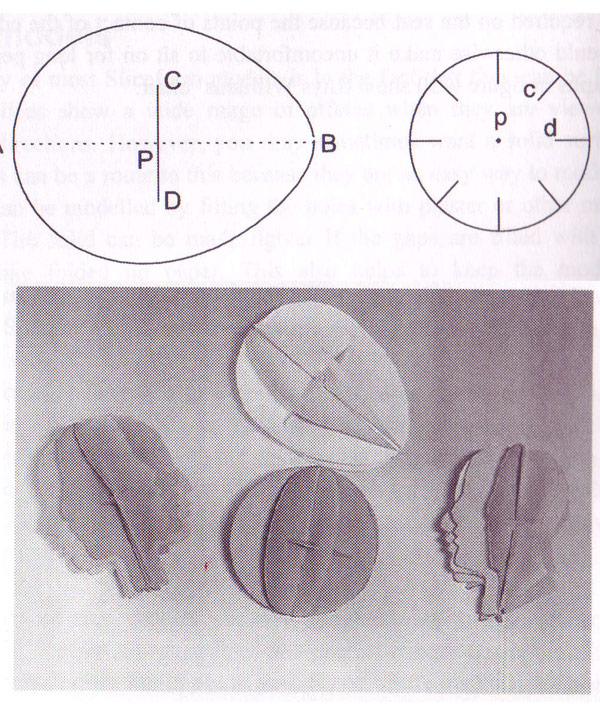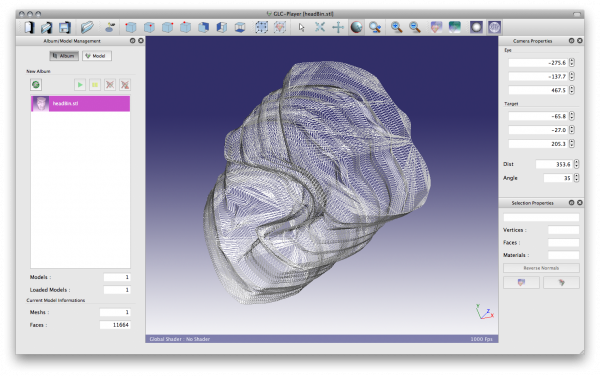Project 3 – Trace Modeler
Concept
Trace Modeler is an experiment with using realtime video to create three-dimensional geometry. The silhouette of a foreground object is subtracted from the background and used as a two-dimensional slice. At user-defined intervals new slices are captured and displaced along the depth axis. My motivation is to create new interfaces for digital fabrication. The geometry created can be exported as an STL mesh ready for 3d printing.
Related Work
Trace Modeler is related to slit scan photography in that slices of information are used (in this case a silhouette) and built up over time. In particular Tamás Waliczky & Anna Szepesi’s Sculptures uses silhouettes of performs to create 3d forms.
I have also been considering approaches for how the forms created can be fabricated. One approach is to use laser-cut planar materials such as the work of John Sharp. Below is one example using radial slices to form the outline of a head.
The ‘Hand-Made’ project by Nadeem Haidary uses video frames of hands to create laser-cutter ready patterns for fabrication using slice-forms.
Trace Modeler
The videos below show how the geometry can be created using anything from shapes drawn on paper, to physical objects, to parts of the body such as hands.
Output
Geometry can be exported as an .STL file (thanks to the ofxSTL library!). This opens up a number of possibilities for working with the mesh in other software as well as for fabrication using a 3d printer. Here is a screen-shot of an exported mesh in a 3d viewer.
Reflection
Processing the geometry was a little more complicated than I thought it would be. There are still problems with the normals that need to be fixed. The mesh resolution is also based on the first slice, with all subsequent slices resampled to match that number of points.
I am interested in implementing radial displacement in the future, in a similar way to the Spatial Sketch project I worked on last year. This would allow the construction of a more diverse range of forms.
I envision this as a general purpose tool that can be used to create 3d forms in an unconventional way. With careful consideration of camera placement, lighting and the objects used I think there are some interesting things that can be done with this as a tool. I am interested in releasing it in the near future to see what people make.





Hi Karl – here are the group comments from the crit.
——————————–
Nice work, Karl!
Also, see the 3D model that professor Pablo Garcia (Architecture) made from interpolated Muybridge horse stills. He would love your project, you should show this to him!!
http://www.pointprojects.com/index.php?/projects/profilograph-after-muybridge/
(p.s. Thanks for sharing info about your capture tool too: iShowU)
fantastic
This is nice, have you thought about smoothing the steps so that there aren’t any sharp corners as one slice progresses to the next?
Nifty. Ok, not shockingly (given your background), you’ve thought of 3D printing this already. 🙂 Look at the similar promotion Fritzing just ran (running the best 24 projects after launch into actual, fabricated PCBs at no charge) in terms of building up publicity for your tool. -SB
Very cool! I kind of wish your final images had smoother edges (actually I saw a smooth setting in your interface so maybe that helps?) from the first image to the last image. I think this is a viable tool. I wish you could’ve printed some of your final images out in 3D…but I know it can be kind of expensive to do that at CMU. Very nice though! I like…I’d definitly be interested in using a tool like this after it’s been primmed up a little more. 🙂 –Amanda